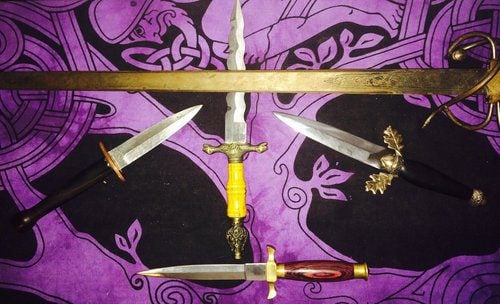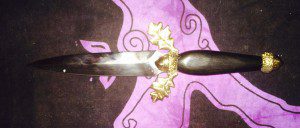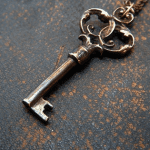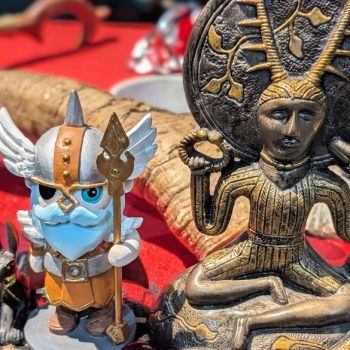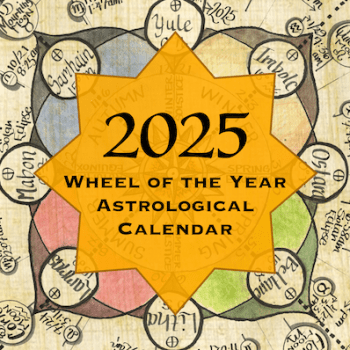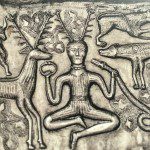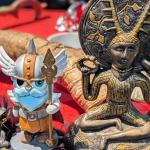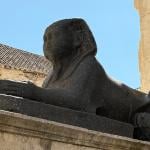 The athame might be the most recognizable tool in the Modern Witch’s Toolbox. It’s a unique instrument, not present in any other major Western religion that I’m aware of. Everyone uses a chalice (or cup), but a ritual knife? Today it’s one that’s mostly all ours. I’ve had a love/hate relationship with the athame over the last twenty years. It was one of the very last ritual tools I purchased (or made), and even then my first athame was “wrong” depending on the context it was being used in.
The athame might be the most recognizable tool in the Modern Witch’s Toolbox. It’s a unique instrument, not present in any other major Western religion that I’m aware of. Everyone uses a chalice (or cup), but a ritual knife? Today it’s one that’s mostly all ours. I’ve had a love/hate relationship with the athame over the last twenty years. It was one of the very last ritual tools I purchased (or made), and even then my first athame was “wrong” depending on the context it was being used in.
The “Athame” is first mentioned in Gerald Gardner’s High Magic’s Aid back in 1949 where it appears as a working tool without much elaboration. It show’s up again in 1954’s Witchcraft Toda (also by Gardner) but he again doesn’t say very much about it, just calling it a “witches knife” and suggesting that most Witch tools are second-hand because older implements have “power.” (1) By the early 1980’s information about the athame was far more detailed. In 1979’s The Spiral Dance Starhawk links the athame to the element of Air and describes it in the way most of us have come to expect:
The athame is traditionally a double-bladed, black-handled knife, but people use anything from kitchen knives to Swiss Army knives complete with corkscrew, so indispensable for opening ritual wine. (2)
I have never seen anyone use a Swiss Army knife as an athame before, but my wife did use a letter opener as one for several years. Curiously by using a letter opener my wife was adhering to an idea first presented by Gardner in Witchcraft Today:
“It is very amusing to see how clever some witches are in disguising their tools so that they look like something else; indeed, they often are something else, until they are put together in the proper way to be used.” (3)
Gardner’s comment from 1954 should probably be taken with a large grain of salt. Most Traditional Witches have pretty solid expectations of just how an athame should look. In those types of circle the athame is usually a double sided blade with a black wooden handle. Some covens even have rules about the blade’s length which sounds a bit obsessive, but makes more sense when it’s remembered that most covens meet in very small circles. A shorter blade most likely keeps people from getting stabbed or poked. Some authors (like Janet and Stewart Farrar) argue that the blade of the athame should be dull (another safety feature) while others think that the blade should be sharp in order to better project one’s will. I’m undecided, though my new athame is pretty sharp.
 For most of the last seventeen years my athame did not conform to the generally accepted standards of “black handle” and “double sided blade” which was a problem in more traditional circles (so much of a problem that I usually just left it at home). Jason’s athame 1.0 has a “wavy” blade, which is most likely too long, and a brown hilt. I remember falling in love with it at my (then) local Witch Shop and one of my roommates buying it for me. Most likely it was manufactured in China (it certainly didn’t cost all that much) and I’m sure it wasn’t specifically designed to be an athame (or that the manufacturers were even aware of athames). I think this particular knife grabbed my attention due to some of the symbols on it and the scabbard. The point of the sheath has a symbol that reminded me of The Church of All Worlds and the knife’s pommel has a god-like figure on the end. There’s even what looks like a sea-shell on the hilt, appropriate considering my ties to Aphrodite.
For most of the last seventeen years my athame did not conform to the generally accepted standards of “black handle” and “double sided blade” which was a problem in more traditional circles (so much of a problem that I usually just left it at home). Jason’s athame 1.0 has a “wavy” blade, which is most likely too long, and a brown hilt. I remember falling in love with it at my (then) local Witch Shop and one of my roommates buying it for me. Most likely it was manufactured in China (it certainly didn’t cost all that much) and I’m sure it wasn’t specifically designed to be an athame (or that the manufacturers were even aware of athames). I think this particular knife grabbed my attention due to some of the symbols on it and the scabbard. The point of the sheath has a symbol that reminded me of The Church of All Worlds and the knife’s pommel has a god-like figure on the end. There’s even what looks like a sea-shell on the hilt, appropriate considering my ties to Aphrodite.
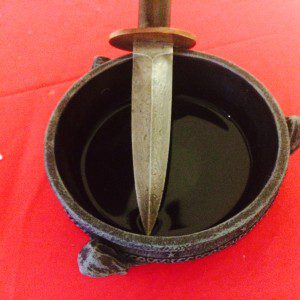 As I got more involved in Gardnerian Craft I began the search for a more traditional blade, a quest that literally took many years. I go to a lot of Pagan Festivals, and there’s usually a knife seller or two there, but they generally don’t sell blades with black handles. Stores closer to home had the same issue, and many of the ones that met the traditional requirements being sold online just looked cheap to me. The “black handle” (especially one made out of wood) can often be elusive, and I realize it’s not all that difficult to stain a brown handle black, but nothing ever really felt “right.” While black handled knives can be hard to track down on the average shopping trip, history has a whole mess of references in regard to black handled knives being used for magical purposes.
As I got more involved in Gardnerian Craft I began the search for a more traditional blade, a quest that literally took many years. I go to a lot of Pagan Festivals, and there’s usually a knife seller or two there, but they generally don’t sell blades with black handles. Stores closer to home had the same issue, and many of the ones that met the traditional requirements being sold online just looked cheap to me. The “black handle” (especially one made out of wood) can often be elusive, and I realize it’s not all that difficult to stain a brown handle black, but nothing ever really felt “right.” While black handled knives can be hard to track down on the average shopping trip, history has a whole mess of references in regard to black handled knives being used for magical purposes.
Often the black handled knife is used against fairies and fairy folk especially in the British Isles. The London Spectator in April of 1895 ran a story about a group of Irish men planning to raid a fairy procession**, with the article referring to the “black-handled knife” as “a potent weapon against all evil spirits.” Perhaps the most curious reference to the black handled knife comes from Dublin University Magazine back in 1849 where the following information appears in a footnote:
“A black-handled knife is an indispensable instrument in performing certain rites, and we shall have occasion to describe its virtues by-and-by. It is employed in the ceremonial of Hallow-Eve, and also in the mystic ceremonies performed at the rising of the new moon, as well as in certain diabolic mysteries made use of to include love etc.” (4)
In addition to the British Isles black-handled knives show up in the magical practices of other cultures. They were used in the Mediterranean to divide and break-up heavy winds and even tornadoes, and references to the practice date back to at least 1727. In Greece black-handled knives were thought to keep away nightmares when placed under a pillow (sleep carefully?) and in some regions was used to get rid of insects. (My wife would argue that the two things are the same.) Those references both come from the same book originally published in 1898. (5) Sixteenth and Seventeenth Jewish grimoires also reference black handled knives and there is some indication that the references date back even further to the Eleventh Century. (6)
I’ve read various reasons for the black handle over the years. Some of them are rather mundane and others more magical. It’s possible that black handles are simply the result of constant use and when tools were more likely to be inherited most people ended up with a black handled knife by default. Scott Cunningham wrote in Wicca: A Guide for the Solitary Practioner that athames have black handles because the color black absorbs energy.
“When the knife is used in ritual to direct energy, some of this is power is absorbed into the handle-only a tiny amount-which can be called upon later. Then again sometimes energy raised within Wiccan ritual is channeled into the knife for later use.” (7)
One theory that has always intrigued me involves blood. Brown handles became black because the handles absorbed a great deal of blood, blood which people used in ritual. I guess if someone cut their palm over and over and it bled into their knife they might end up with that effect.
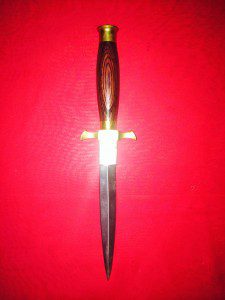 Two years ago as my hunt for the elusive “perfect athame” intensified I ordered a very standard athame with a wooden handle online. The handle its self was brown but as I was at the point of giving up I decided I’d just stain it at some point. Oddly I ended up losing this particular athame for the better part of a year and only recently found it again. I never did get around to staining it either. It’s perfectly serviceable but I don’t have a history with it or a deep amount of attachment towards it, I kind of feel like it’s the sad little athame that Jason didn’t really want.
Two years ago as my hunt for the elusive “perfect athame” intensified I ordered a very standard athame with a wooden handle online. The handle its self was brown but as I was at the point of giving up I decided I’d just stain it at some point. Oddly I ended up losing this particular athame for the better part of a year and only recently found it again. I never did get around to staining it either. It’s perfectly serviceable but I don’t have a history with it or a deep amount of attachment towards it, I kind of feel like it’s the sad little athame that Jason didn’t really want.
Critics of Gerald Gardner have sometimes speculated that the use of the athame comes from Gardner’s personal interest in knives. I myself once believed that there might be some validity to the idea, and I was completely wrong. As we’ve already seen people have been using black handled knives for at least a couple of centuries. Knives without reference to any specific type of handle are even easier to find in the historical record. They appear in Francis Barrett’s The Magus and Joseph Smith’s (the founder of the Latter Day Saints) family had their own magical dagger inspired by Barrett’s book. The magical knife also appears in The Key of Solomon, a fourteenth or fifteenth century work depending on who one asks.
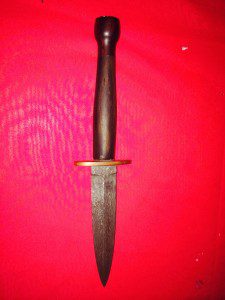 Gardner’s inclusion of a ceremonial knife shouldn’t have surprised anyone in 1954, however his use of the word “athame” most likely would have. “Athame” as a word doesn’t exist before Gardner (and/or his initiators), though there are several words that are similar. Most of these “variant spellings” are found in various French versions of The Key of Solomon. The French artave, arthane, and arthame are probably garbled versions of artavus, a Medieval Latin word meaning penknife and described as “a small knife used for sharpening the pens of scribes.” (8) In 1927 the word arthana shows up in the book Mysteries and Secrets of Magic where the author quotes a 1572 edition of the Key of Solomon. Mysteries and Secrets also contains a picture showing both white and black handled knives for use in magic. (9) In The Magus the sun is referred to as Athemay (hey, that’s how I say it!), with the idea being borrowed from the Heptameron which dates back to the Fourteenth Century. (10)
Gardner’s inclusion of a ceremonial knife shouldn’t have surprised anyone in 1954, however his use of the word “athame” most likely would have. “Athame” as a word doesn’t exist before Gardner (and/or his initiators), though there are several words that are similar. Most of these “variant spellings” are found in various French versions of The Key of Solomon. The French artave, arthane, and arthame are probably garbled versions of artavus, a Medieval Latin word meaning penknife and described as “a small knife used for sharpening the pens of scribes.” (8) In 1927 the word arthana shows up in the book Mysteries and Secrets of Magic where the author quotes a 1572 edition of the Key of Solomon. Mysteries and Secrets also contains a picture showing both white and black handled knives for use in magic. (9) In The Magus the sun is referred to as Athemay (hey, that’s how I say it!), with the idea being borrowed from the Heptameron which dates back to the Fourteenth Century. (10)
I’m inclined to believe that the word athame is most likely a corruption of one of the many words used for magical knife in The Key of Solomon. The similarities are too obvious, and Gardner uses symbols from Solomon to decorate the handle of the magical knife described in his 1948 novel High Magic’s Aid. Other theories have emerged though, and are worth sharing in an effort to be thorough. Idries Shah, a contemporary of Gardner and most likely his first biographer***, speculated in his book Secret Societies (1961) that athame might derive from the Arabic term al-dhamme which translates as blood-letter. (11) The French word attame which means to cut or pierce is another possible, though I think unlikely, source. (12)
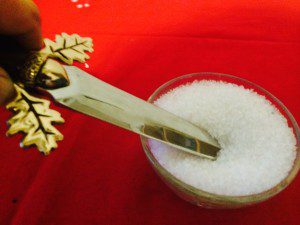 For the last couple of years my wife has used a very tiny athame (so tiny that it was the only one I couldn’t find for our “pointy things family photo”) in ritual. Like certain other tools it’s not the size of the athame that matters but how it’s used, only that a smaller blade makes some tasks more difficult. Unless one is a Kitchen Witch extrordinaire athames are rarely used for cutting. They are generally used in the circle to direct energy (cast circles, draw pentagrams at the Watchtowers) but they also have a few physical uses. We prepare both water and salt with our blades, and it’s far easier to get salt on a five inch blade than it is on a three inch one.
For the last couple of years my wife has used a very tiny athame (so tiny that it was the only one I couldn’t find for our “pointy things family photo”) in ritual. Like certain other tools it’s not the size of the athame that matters but how it’s used, only that a smaller blade makes some tasks more difficult. Unless one is a Kitchen Witch extrordinaire athames are rarely used for cutting. They are generally used in the circle to direct energy (cast circles, draw pentagrams at the Watchtowers) but they also have a few physical uses. We prepare both water and salt with our blades, and it’s far easier to get salt on a five inch blade than it is on a three inch one.
My wife had the same sort of troubles I did finding the right blade. This past February she finally found her athame while we strolled the vendor room at PantheaCon. Like most good blades it was expensive and we were both planning on behaving ourselves amongst the merchants, but she couldn’t resist. After several hours of internal monologue and debate she purchased her prize, and when I held it in my hand I completely understood why she liked it so much. It has a weight and a presence that matches her intensity in ritual.
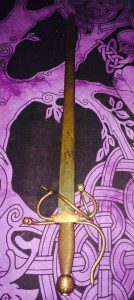 For years most of my magical tools have simply showed up when I needed them. Despite my problems acquiring the “dream trad knife” I’ve had a wonderful sword for fifteen years now, and that was a gift from a friend. My sword actually lines up with some of Gardner’s suggestions, it just had it’s 114th birthday. Manufactured in Toledo Spain I have no idea how this sword ended up with my friend Dwayne, but I’m grateful it did. I’ve often thought of polishing it up, but most of my coven thinks its current world weary look gives it a special dignity. This sword has travelled with me a lot the last couple of years too, showing up at a variety of festivals and most likely TSA bag searches.
For years most of my magical tools have simply showed up when I needed them. Despite my problems acquiring the “dream trad knife” I’ve had a wonderful sword for fifteen years now, and that was a gift from a friend. My sword actually lines up with some of Gardner’s suggestions, it just had it’s 114th birthday. Manufactured in Toledo Spain I have no idea how this sword ended up with my friend Dwayne, but I’m grateful it did. I’ve often thought of polishing it up, but most of my coven thinks its current world weary look gives it a special dignity. This sword has travelled with me a lot the last couple of years too, showing up at a variety of festivals and most likely TSA bag searches.
This past Friday after a five month wait I finally received the athame I’ve been dreaming about for the last twenty years. In December my wife shared a photo of “an acorn knife” from Omega Artworks with me and I was immediately in love. (Can one love a knife? In this case yes.) I think I made a “squee” sound when I first saw it but tried to hide my enthusiasm thinking that I’d end up with it for Yule. The Holidays came and went (including my birthday) but no new athame. I asked my wife it would be OK if I used my “Christmas Bonus” from my 12 hour a week mundane job to purchase my dream blade. She said it would be fine and then after a three month wait it arrived this past Friday. Handmade with care and precision . . . double sided . . . black handle . . . . it’s everything my athame is supposed to be. With my circle named The Oak Court and with acorns being sacred to Pan the ornamentation is absolutely perfect too. From the Key of Solomon to my Temple Room the history of the athame is a long and winding one, but it does have a very happy ending.
FOOTNOTES
1. Witchcraft Today by Gerald Gardner, page 126 in the printing I own. The little Gardner has to say about the athame can be found under the subheading “The Witch’s Tools.”
2. The Spiral Dance by Starhawk page 62. I’m using the original 1979 printing here. Harper and Row Publishers. Curiously Starhawk puts the word athame in italics repeatedly in The Spiral Dance, and also simply refers to it as the “knife” when describing ritual.
3. Witchcraft Today also page 126.
4. All of those stories come from Wicca: Magical Beginnings by Sortia d’Este and David Rankine published in 2008 by Avalonia Press and appear on pages 82 and 83. You can also read a few more on d’Este’s website.
5. Wicca: Magical Beginnings pages 84-85
6. Wicca: Magical Beginnings page 86
7. Wicca: A Guide for the Solitary Practiioner by Scott Cunningham published in 1988 by Llewellyn Press. The quote comes for page 30. Cunningham generally refers to the athame as “the magic knife” and links it to fire.
8. Wicca: Magical Beginnings page 71
9. Magical Religion and Modern Witchcraft, James R. Lewis editor, published in 1996 by State University of New York Press page 176. This comes from James W. Baker’s contribution White Witches which includes a lot of information about athames. Baker argues that the origins of both the athame and the boline most likley come from C.J.S. Thompsons’ Mysteries and Secrets of Magic.
10. Wicca: Magical Beginnings page 72
11. Wicca: Magical Beginnings page 73
12. Magical Religion/White Witches page 177
THE PICTURES
1. My new athame
2. “Old Wavy” the athame I’ve used for the past sixteen or seventeen years
3. My wife’s blade cleansing water for ritual
4. The Mankey “Pointy Things Family Picture.”
5. My second athame, barely used, and recently recovered after a ten month loss.
6. The blade of my wife, purchased this year at PantheaCon
7. I purify thee o creature of salt!
8. Sword from Toledo Spain
9. The Acorn Athame from Omega Artworks
OTHER NOTES
*The pronunciation of athame often varies. I say “ah-thuh-may,” most of my friends on the West Coast pronounce it “uh-thaahh-me” and I once saw a bumper sticker alluding to the word rhyming with whammy (I’ll give you a whammy with my “uh-tha-mee”). I don’t think there’s a right or wrong here.
**Belief in fairies was widespread at the time, and they were often seen as a malevolent.
***The book Gerald Gardner: Witch is credited to Jack Bracelin but is widely thought to have been written by Shah. (While writing that note it dawned on me just how long this article is. I did not mean to write a 2600 word monster.)
I’m hoping to run another article like this in the future, you can help me make that a reality by sharing this particular piece of writing on social media.


